lordroel
Administrator
Posts: 68,096 
Likes: 49,492
|
Post by lordroel on Mar 12, 2021 8:59:37 GMT
Day 915 of World War II, March 12th 1942Eastern FrontTen Soviet parachutists land near Birza, Lithuaniai to commit sabotage. They are seen, chased and shot, and all their equipment, including a radio transmitter, seized by German forces. Photo: Leningradians cleaning a street after the first winter in the besieged city Battle of the Atlantic Battle of the Atlantic U-126 sinks 2 US freighters 20 miles North of Puerto Padre Bay, Cuba; SS Texan at 2.34 AM (all 47 crews abandons ship in 2 lifeboats but both capsize as Texan sinks, 9 drowned, 38 survivors picked up at 5.30 M next morning by Cuban fishing boat Yoyo) and SS Olga at 6.11 AM (1 dead, 32 survivors). In the early hours 520 miles Northeast of the British Virgin Islands, Italian submarine Morosini sinks British freighter Manaqui. The first British armed trawlers sent to augment U.S. Navy patrol force efforts off the German submarine-plagued Eastern Seaboard, HMS 'Wastwater' and HMS 'Le Tigre', begin patrol operations in the Third Naval District waters. They are assigned duties off Atlantic City and Barnegat, New Jersey, U.S.A. Air War over EuropeDuring the night of the 12th/13th, RAF Bomber Command attacks Emden and Kiel. Twenty Wellingtons and 20 Whitleys are dispatched to Emden; 22 bomb with three Whitleys lost but bombing photographs indicate that the nearest bombs were 5 miles (8 kilometers) from the target. At Kiel, 68 Wellingtons are dispatched to attack the Deutsche Werke U-boat yard; 53 aircraft bomb and reports from Kiel indicate that the port area was successfully bombed, with damage in the Deutsche Werke and the Germania Werft yards, both building U-boats, and in the naval dockyard. Casualties are listed as 12 killed and 21 injured but it is not known whether service personnel were included. Five Wellingtons are lost over Kiel. In the final mission of the night, 16 aircraft lay mines off German ports. During the night of the 12th/13th, an RAF Bomber Command Hampden flies a leaflet mission. United StatesPresident Franklin D. Roosevelt signs an executive order combining the duties of Commander in Chief U.S. Fleet and the Chief of Naval Operations (CNO). Admiral Ernest J King, Commander-in- Chief U.S. Fleet, is designated to replace Admiral Harold R Stark as Chief of Naval Operations (CNO) effective 26 March. Pacific WarANDAMAN ISLANDS The garrison (a British company and a Gurkha battalion) of this group of islands in the Bay of Bengal is withdrawn, since the loss of Rangoon, Burma, makes it unfeasible to maintain this seaplane base. BURMA The Burma Army establishes headquarters at Maymyo. NETHERLANDS EAST INDIES On Java, the senior American, Australian and British officers sign a formal surrender document with the Japanese at their headquarters in Bandoeng. INDIA Three transports arrive at Karachi after sailing from Australia. Aboard the three ships are the ground echelons of the USAAF's 7th BG (Heavy) and 88th Reconnaissance Squadron (Heavy) arriving from Australia and the 16th and 25th Pursuit Squadrons, 51st Pursuit Group from the U.S. Cargo aboard the ships includes ten crated P-40s. The 51st Pursuit Group's P-40s had been aboard the seaplane tender USS Langley when she was sunk on 27 February. JAPAN Japanese Prime Minister General TOJO Hideki urges Australia to submit to Japanese rule or face an invasion like the recently conquered Dutch East Indies. NEW CALEDONIA U.S. Army troops (Brigadier General Alexander M. Patch) land on New Caledonia Island to establish a base at Noumea. The Army unit is Task Force 6814 consisting of 17,500 men of the 51st Infantry Brigade headquarters and the 132d and 182d Infantry Regiments plus supporting units. One of the soldiers landing that day was Bill McLaughlin. He writes, "We had been about 37 days from Brooklyn, New York, to Melbourne, Victoria, Australia, and then about a week or ten days in Bendigo, Victoria, 40 miles inland from Melbourne. Back on the ship for another ten days to New Caledonia. It was found that the harbor was too shallow to allow our ship to dock, and we had to go over the side into small boats to take us ashore. There, we were marched through the streets (sea legs and all), and another long haul out to our first bivouac area, and a horde of mosquitoes. Many years later, writing a native of Noumea, Henri Daly, I mentioned that the sullen faces we saw all thru our march in Noumea, showed most of them were pro Vichy French. He wrote back, 'Oh, Bill, did you ever think how most of the adults felt seeing some 15,000 lusty American youth, coming into our small country?' I still think I was right..the next month we saw the countrymen moving on to Noumea, in protest with their rifles, and driving out the Vichys." PHILIPPINE ISLANDS Three-quarters of the Americans and Filipinos troops defending Bataan and Corregidor now have major health problems. An estimated 500 to 700 per day are coming down with malaria and dysentery is rampant from drinking tainted water. Meanwhile, the Japanese are bringing in fresh infantry and artillery units from China. During the night of the 12th/13th, the four motor torpedo (PT) boats carrying General Douglas MacArthur, Commanding General U.S. Army Forces, Far East, his family, Rear Admiral Francis W. Rockwell, Commandant Sixteenth Naval District, and their staffs from Luzon to Tagauayan Island in the Cuyo Group became separated. PT-32 could only use two of its three engines and the other boats had to stop from time to time to clean gasoline strainers. The first boat to arrive at Tagauayan was PT-34 at 0930 hours, two hours late; in the late afternoon, PT-41 and PT-42 arrive in the cove from other islands where they had hidden during the morning hours. PT-35 was missing. Because of the condition of PT-32, the passengers on this boat were divided between the other two boats and these two refueled using fuel drums carried as deck cargo. The crew of PT-32 was ordered to remain at Tagauayan to await the arrival of the submarine USS Permit and PT-35 and give directions to the captains of both vessels and then the PT-32 could get underway for Panay Island to obtain fuel. At 1800 hours, PT-34 and PT-41 get underway for Cagayan on Mindanao Island.
|
|
lordroel
Administrator
Posts: 68,096 
Likes: 49,492
|
Post by lordroel on Mar 13, 2021 14:39:36 GMT
Day 916 of World War II, March 13th 1942YouTube (Tumbling Capitals - MacArthur on the Run)Eastern Front The Soviet Army launches an attack against German Heeresgruppe B (General Erich von Manstein) from the Kerch peninsula in the eastern Crimea. The Soviets lose 130 tanks in three days. Photo: Soviet anti-aircraft gunners preparing a gun for the battle in Marsovo Pole in Leningrad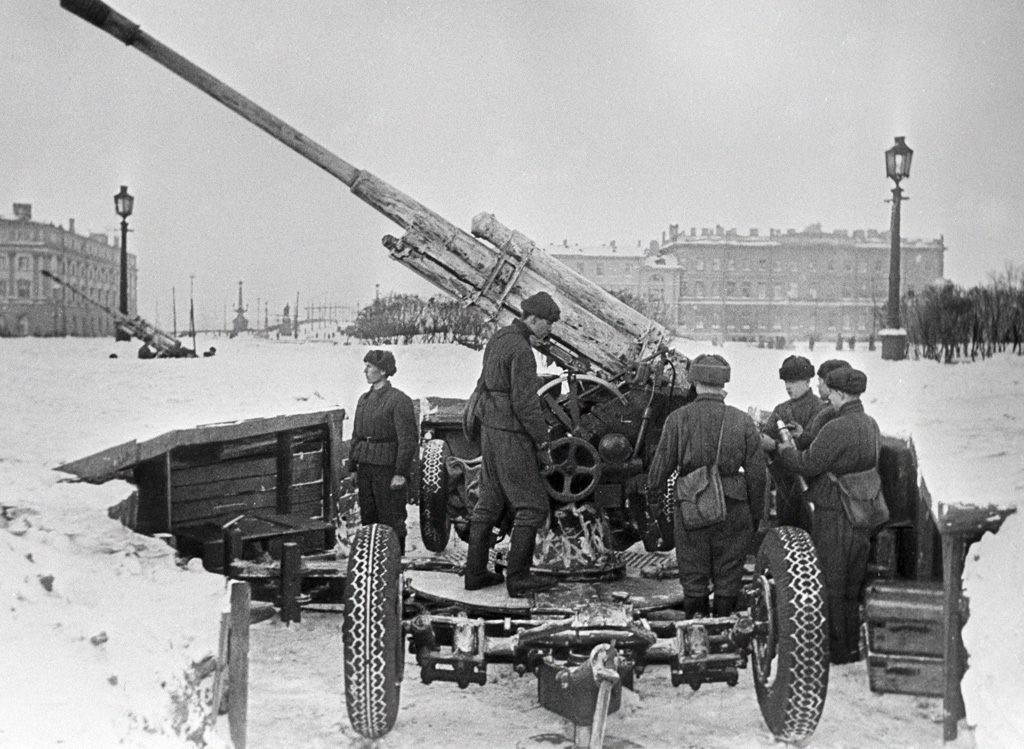 Air War over Europe Air War over EuropeDuring the night of the 13th/14th, RAF Bomber Command dispatches 135 aircraft of 6 different types to attack Cologne; 112 aircraft bomb the target and a Manchester is lost. This can be considered the first successful Gee-led raid. Although there was no moon, the leading crews carrying flares and incendiary-bomb loads locate the target and much accurate bombing follows. It is later estimated that this raid was five times more effective than the average of recent raids on Cologne. There were 237 separate fires and casualties were 62 killed and 84 injured. One aircraft visually bombs Bonn while five Hampdens lay mines in the Frisian Islands. During the night of the 13th/14th, two RAF Bomber Command aircraft bomb the port area at Ostend. Ten of 11 RAF Bomber Command Bostons attack the Hazebrouck marshalling yard without loss during the day. During the night of the13th/14th, seven of the 20 aircraft dispatched bomb the port area at Boulogne (a Wellington is lost); one aircraft bombs the port area at Calais; 11 of 19 Wellingtons dispatched bomb the port area at Dunkirk (two aircraft are lost); and five of seven Hampdens dispatched drop leaflets. During the night of the 13th/14th, one RAF Bomber Command bomber attacks Schipol Airfield. Battle of the CaribbeanAxis submarines continue to feast on unescorted shipping off the US East coast. 330 miles off Palm Beach, Florida, Italian Tazzoli sinks British SS Daytonian (1 killed, 58 survivors). At 4.41 AM 10 miles off Cape Guajaba, Cuba, U-126 torpedoes American SS Colabee which runs aground (23 killed, 14 survivors make land in a lifeboat). SS Colabee will be towed into Nuevitas by the Cuban Navy then repaired at Tampa, Florida, and returned to service in September 1942. At 5.05 AM 39 miles off Cape Fear, North Carolina, a torpedo from U-158 ignites US tanker John D. Gill carrying 141,981 barrels of crude oil from Texas to Philadelphia (23 dead, 26 survivors). At 6.43 AM 5 miles off Asbury Park, New Jersey, U-404 sinks neutral Chilean SS Tolten in ballast (26 killed, 1 survivor). 200 miles off Cape Hatteras, North Carolina, U-332 sinks unarmed WWI-era 4-masted schooner Albert F. Paul at 7.20 AM (all 8 hands lost) and Yugoslavian SS Trepca at 5.47 PM (4 dead, 33 survivors picked up by a Swedish merchant). Battle of the Mediterranean 5 miles off the coast of Tunisia, British submarine HMS Una sinks tiny Italian fishing boat Maria Immacolata with the deck gun. United StatesHQ USAAF activates HQ XII Bomber Command at MacDill Field, Tampa, Florida. Pacific WarBISMARCK ARCHIPELAGO A Japanese force from the 4th Fleet sails from Rabaul, New Britain Island, for Buka Island, Solomon Islands, which is eventually seized together with other positions in the northern Solomons. INDIA The first detachment of U.S. troops (USAAF personnel) to reach the China-Burma- India Theater arrive at Karachi, having been diverted from Java, Netherlands East Indies. NEW GUINEA The Japanese, having gained firm positions in the Lae-Salamaua area, replace infantry with naval forces. During a Japanese strafing attack, a Ford Trimotor A45-2 is destroyed on the ground at 7-Mile Drome. NEW ZEALAND Japanese submarine I-25 launches a "Glen" submarine launched patrol plane to reconnoiter Auckland. PACIFIC Submarine USS Gar torpedoes and sinks a Japanese victualling stores ship between 6 and 10 miles SW of Mikura Jima, south of Tokyo Bay. PHILIPPINE ISLANDS The two motor torpedo (PT) boats carrying General Douglas MacArthur, his family, Rear Admiral Francis W. Rockwell and their staffs, PT-34 and PT-41, arrive at Cagayan on Mindanao Island in the early morning. Later in the day, a third boat, PT-35, arrives at Cagayan. The three boats had made the 560-mile voyage in heavy to moderate seas in two days. The next leg of MacArthurâs journey to Australia is to be by B-17's but only one B-17 has reached Del Monte Field and it had wheezed in to a wobbly landing. MacArthur, furious, will allow no one to board the "dangerously decrepit" aircraft, and demands the "three best planes in the U.S. or Hawaii," manned by "completely adequate, experienced" airmen be flown to Del Monte. Unfortunately, Major General George Brett, Commanding General U.S. Army Forces in Australia, has neither. The party must now await the arrival of three additional B-17 Flying Fortresses from Australia. The submarine USS Permit arrives at Tagauayan Island and finds the fourth motor torpedo (PT) boat involved in the evacuation of the MacArthur party, PT-32, there. The PT boat is not seaworthy and the submarines takes the boat's crew aboard and PT-32 is destroyed by gunfire. CHINA-BURMA-INDIA THEATER OF OPERATIONS (10th Air Force): 26th Pursuit Squadron, 51st Pursuit Group, arrives at Karachi, India from the US with P-40's; first mission is 15 Oct. SOUTHWEST PACIFIC AREA (5th Air Force): 36th Pursuit Squadron, 8th Pursuit Group, transfers from Brisbane to Lowood, Australia with P-39's.
|
|
lordroel
Administrator
Posts: 68,096 
Likes: 49,492
|
Post by lordroel on Mar 14, 2021 7:11:58 GMT
Day 917 of World War II, March 14th 1942
Battle of the Atlantic
In the English Channel off Dover, 6 British motor torpedo boats and 3 motor gunboats attack German armed merchant cruiser Michel but are driven off by the escorting minesweepers and torpedo boats. At dawn, British attack again with 5 destroyers (HMS Blencathra, Calpe, Fernie, Walpole, Windsor) and motor torpedo boats. Michel drops her disguise and opens fire with six 6-inch guns, damaging HMS Fernie and HMS Walpole. Michel escapes to Le Havre, France, with slight damage (1 killed).
Battle of the Caribbean
200 miles West of Caribbean island of Dominica, U-67 sinks Panamanian tanker Penelope at 2 AM (2 dead, 47 survivors) and U-161 sinks Canadian SS Sarniadoc (all 21 hands lost). At 8.28 AM off Atlantic City, New Jersey, U-404 sinks US freighter SS Lemuel Burrows (20 dead, 14 survivors). At 9.18 PM 260 miles North of Bermuda, U-124 ignites British tanker MV British Resource carrying 10,000 tons of volatile benzene and white spirit (46 killed, 5 survivors picked up by British corvette HMS Clarkia and landed at Hamilton, Bermuda). MV British Resource burns all night and sinks next day.
Battle of the Mediterranean
17 miles East of Gibraltar, Italian submarine Mocenigo sinks French vessel Ste. Marcelle. At 1.23 PM off Calabria in the Ionian Sea, British submarine HMS Ultimatum spots Italian submarine Millo returning to port at Taranto, running on the surface. HMS Ultimatum sinks Millo with 4 torpedoes (55 killed, 14 survivors picked up by HMS Ultimatum, 1 survivor rescued a few hours later by a coastal patrol boat). At 5 PM, U-133 leaves base at Salamis Island, near Athens, Greece, but hits a mine and sinks 2 hours later (all 45 hands lost). There is a myth that U-133 sailed up the Colorado River to destroy the Hoover Dam.
Pacific War
AUSTRALIA
Japanese aircraft bomb Horn Island located 10 miles off the northern coast of Queensland. Horn Island, in the Torres Strait between Queensland and New Guinea, will become the main tactical base for Allied air operations in the Torres Strait. The island will be subject to nine Japanese air raids during WWII.
CHINA-BURMA-INDIA THEATER OF OPERATIONS
(10th Air Force): HQ 51st Pursuit Group arrives at Karachi, India from the US. 9th Bombardment Squadron (Heavy), 7th BG (Heavy), arrives at Karachi, India from Australia with B-17's; first mission is 2 Apr.
SOUTHWEST PACIFIC AREA
(5th Air Force): 13th Reconnaissance Squadron (Heavy), 43d BG (Heavy), transfers from Melbourne to Laverton, Australia with B-17's; the 13th will be redesignated 403d BS on 22 Apr; first mission is Oct 42. Air echelon of 14th BS (Heavy), 7th BG (Heavy), ceases operating from Melbourne, Australia with B-17's; men and equipment are transferred to other units; the ground echelon is at Bugo, Mindanano and fights as infantry; the unit is carried as an active unit but is not manned or equipped after the surrender of the Philippiness in May 42.
Detachment of the 22d BS (Heavy), 7th BG, ceases operating from Townsville and returns to base at Melbourne with B-17's. 40th Reconnaissance Squadron is formed at Townsville, Australia with LB-30's and assigned to 19th BG (Heavy); first mission is today; squadron is redesignated 435th BS (Heavy) on 22 Apr. Air echelon of 88th Reconnaissance Squadron (Heavy), 7th BG (Heavy), ceases operating from Townsville, Australia with B-17's and begins moving to Karachi, India; squadron is redesignated 436th BS on 22 Apr; first mission in CBI is 4 Jun.
UNITED STATES
The U.S. Joint Chiefs of Staff decide to continue on the defensive in the Pacific with forces already there and to build up forces in United Kingdom for an offensive against Germany. German submarines have sunk so many tankers during the past two months that the War Production Board orders gasoline deliveries be cut 20 percent in 17 eastern states and the District of Columbia.
|
|
lordroel
Administrator
Posts: 68,096 
Likes: 49,492
|
Post by lordroel on Mar 15, 2021 3:53:21 GMT
Day 918 of World War II, March 15th 1942Eastern Front Soviet submarine ShCh210 goes missing off Cape Shabla, Bulgaria, presumably lost to a Romanian minefield. Battle of the AtlanticIn the North Sea, 20 miles off the English coast, German motor torpedo boats attack British coastal convoy FS749. Torpedo boat S-104 sinks British destroyer HMS Vortigern (110 killed, 14 survivors rescued by British patrol sloop HMS Guillemot). 245 miles Southeast of St. John’s, Newfoundland, a PBO-1 Hudson covering convoy ON-72 (Naval Squadron VP-82, from Argentia, Newfoundland) sinks U-503 with depth charges (all 51 hands lost). 15 miles off Cape Fear, North Carolina, U-158 damages US tanker SS Olean at 06.04 AM (6 killed, 36 survivors) and sinks US tanker SS Ario at 07.22 AM (8 dead, 26 survivors picked up by US destroyer USS Du Pont). 270 miles East of Palm Beach, Florida, Italian submarine Tazzoli sinks British SS Athelqueen (3 killed, 46 survivors). Tazzoli collides with SS Athelqueen, damaging the forward torpedo tubes, and is forced to abort the mission and arrives back at base in Bordeaux, France on March 31. At midday South of Haiti, U-161 sinks US Coast Guard lighthouse tender USCGC Acacia with 68 shells from the deck gun and 162 rounds from the 37mm & 20mm anti-aircraft guns (all 36 hands rescued by US destroyer USS Overton and taken to San Juan, Puerto Rico). GermanyAt a staff meeting in Berlin, Adolf Hitler and his generals study the situation in the Soviet Union. Moscow has not fallen, and will not fall. German casualties from Soviet firepower and frostbite have been immense, but the Soviet counterattack at Moscow, Staraya Russa, and the Crimea is petering out as the Soviets run out of supplies. The initiative is going back to the Germans, and Hitler forecasts the annihilation of the Soviet Army in summer. That evening, at the Sportspalast Hitler announces that the Soviet Union will be "annihilatingly defeated" in the next summer offensive. Air War over EuropeDuring the night of the 15th/16th, three RAF Bomber Command Blenheims are dispatched on Intruder flights to Dutch airfields. Schiphol Airfield is attacked by one aircraft. Six RAF Bomber Command Bostons fly uneventful shipping sweeps off Brittany during the day. United KingdomBritish Lord Privy Seal Sir Stafford Cripps leaves London to negotiate with Indian leaders who want independence. Cripps will offer freedom after the war. Hindu leaders Mahatma Gandhi and Jawaharal Nehru demand immediate independence for a unified India while Moslem League President Mohammed Ali Hinnah wants a separate Pakistan. United StatesThe Maritime Commission places orders for another 234 "Liberty" ships -- slow-moving 10,500-ton merchant vessels. Pacific WarALASKA The XI Interceptor Command is activated at Elmendorf Field, Anchorage. Its operational components are the 11th and the 18th Pursuit Squadrons. BURMA Lieutenant General Joseph Stilwell, Commanding General American Army Forces, China, Burma and India, is notified that British General Archibald Wavell, Commander in Chief India, is responsible for operations In Burma. NEW CALEDONIA The 67th Pursuit Squadron, the first USAAF tactical unit in the theater, arrives from the U.S. with 45 crated P-400 Airacobras. NEW ZEALAND New Zealand begins to experience tire shortages due to reduced rubber supplies. PHILIPPINE ISLANDS In the Manila Bay area the Japanese, having emplaced additional artillery along the southern shore of Manila Bay southwest of Ternate, renew intensive bombardment of fortified islands in the bay. The shelling is conducted daily and in great force through 21 March, despite U.S. counterbattery fire. Forts Frank and Drum are particularly hard hit. At Del Monte Airfield on Mindanao, General Douglas MacArthur, Commanding General U.S. Army Forces, Far East, and his party wait for B-17's to take them to Australia. Officers in Melbourne, Victoria, Australia, are trying to scrape together the necessary aircraft. While MacArthur waits, his aide, Sid Huff, takes Jean MacArthur's mattress off motor torpedo (PT) boat PT-41 which leads to a wild story that the mattress is supposedly full of gold bars. In fact, it's full of feathers. Map: Route of MacArthur's escape by PT boat (red) and B-17 (blue)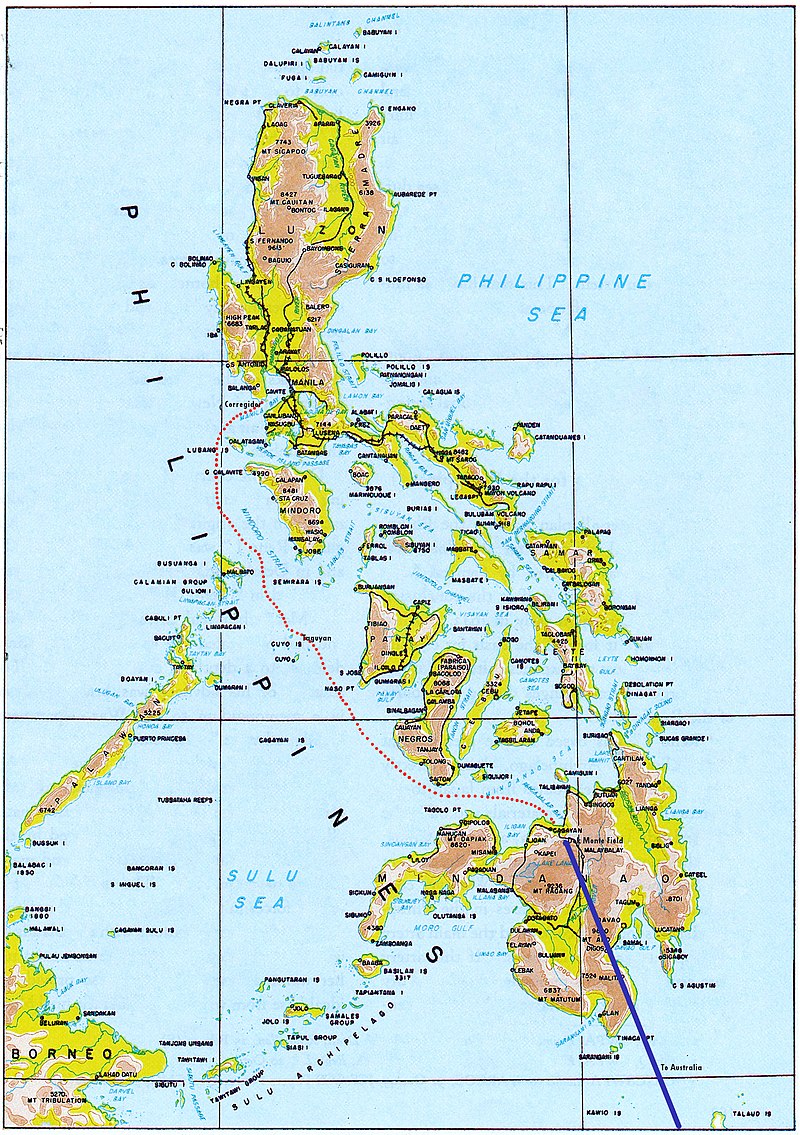
|
|
lordroel
Administrator
Posts: 68,096 
Likes: 49,492
|
Post by lordroel on Mar 16, 2021 3:49:48 GMT
Day 919 of World War II, March 16th 1942Eastern FrontWith the Soviet offensive stalling and the front stabilizing, it is apparent that the Red Army has failed to remove the German threat to Moscow. Sevastopol is still besieged and the siege of Leningrad is in its 190th day. Stalin begins pressing Britain and America to open a second front with an invasion of Western Europe. Eastern Front: German occupation of Oryol in winter 1942 Battle of the Mediterranean Battle of the MediterraneanOvernight 145 miles Northeast of Antigua, Italian submarine Morosini sinks Dutch tanker MV Oscilla (4 killed, 51 survivors). Battle of the Caribbean300 miles North of San Juan, Puerto Rico, U-504 sinks British SS Stangarth on her maiden voyage from New York carrying ammunition, trucks and aircraft parts to Bombay, India (all 46 hands lost). At 7.55 PM 10 miles off Cape Hatteras, North Carolina, U-332 sinks US tanker MV Australia (4 dead, 36 survivors picked up by American SS William J. Salman). At 11.17 PM 6 miles South of Cape Palmas, Liberia, West Africa, U-68 sinks British SS Baron Newlands (18 killed, 20 survivors). Pacific War SOUTHWEST PACIFIC AREA (5th Air Force): 3 B-17's of the 40th Reconnaissance Squadron (Heavy), 19th BG begin evacuating General Douglas MacArthur, his family, and his staff from Del Monte, Mindanao, Philippines to Australia. 39th Pursuit Squadron, 35th Pursuit Group, transfers from Ballarat to Mount Gambier, Australia with P-39's; first combat is 2 Jun. 64th Bombardment Squadron, 43d BG, arrives at Sydney, Australia from the US with B-17's; first mission is 13 Aug. 68th Pursuit Squadron, 58th Pursuit Group, arrives at Amberly Field, Australia from the US with P-39's. PHILIPPINE ISLANDS Japanese siege guns bombard American forts in Manila Bay. One 240 mm shell detonates beneath a Fort Frank powder room, breaking up the concrete and hurling some 60 (filled) powder cans about. Miraculously, none of them explode or catch fire. Submarine USS Permit delivers ammunition to Corregidor Island, and evacuates the second increment of naval radio and communications intelligence people. On Mindanao Island, two B-17's arrive just before 2400 hours, the runway lit by two flares, one at each end. Lead pilot Lieutenant Frank P. Bostrom drinks eight cups of coffee to fortify himself for the return flight while mechanics repair his defective supercharger. Bostrom tells General Douglas MacArthur his party must abandon their luggage and Jean MacArthur boards carrying only a silk scarf and a coat with a fur collar.
|
|
lordroel
Administrator
Posts: 68,096 
Likes: 49,492
|
Post by lordroel on Mar 17, 2021 3:49:46 GMT
Day 920 of World War II, March 17th 1942Battle of the AtlanticOff the East coast of America. U-404 sinks British SS San Demetrio (19 killed, 32 survivors picked up after 2 days by American merchant Beta). U-124 sinks Honduran banana boat SS Ceiba (44 killed including wives and children of the crew, 6 survivors picked up two days later by US destroyer USS Hambleton). US aircraft carrier USS Wasp collides with US destroyer USS Stack (flooding the boiler room). USS Stack is repaired in the Philadelphia Navy Yard., U-373 sinks Greek SS Mount Lycabettus (all 30 hands lost). U-71 sinks Norwegian tanker Ranja (all 34 hands lost). Off the coast of Tabou West Africa, near the border of Liberia and Ivory Coast, U-68 sinks 3 British freighters; SS Ile de Batz (4 killed, 39 survivors make land at Cape Palmas, Liberia), MV Scottish Prince, (1 dead, 38 survivors make land at Cape Palmas) and SS Allende (6 killed, 33 survivors in 2 lifeboats make land at Tabou, Ivory Coast, but are interned by the Vichy French). Battle of the Mediterranean15 miles South of Calabria, British submarine HMS Unbeaten sinks Italian submarine Guglielmotti (46 killed). HMS Unbeaten surfaces to rescue 12 survivors but is driven off by an Italian aircraft. The 12 survivors are later rescued by 3 motor torpedo boats which also drop 24 depth charges causing no damage. Photo: submarine Guglielmotti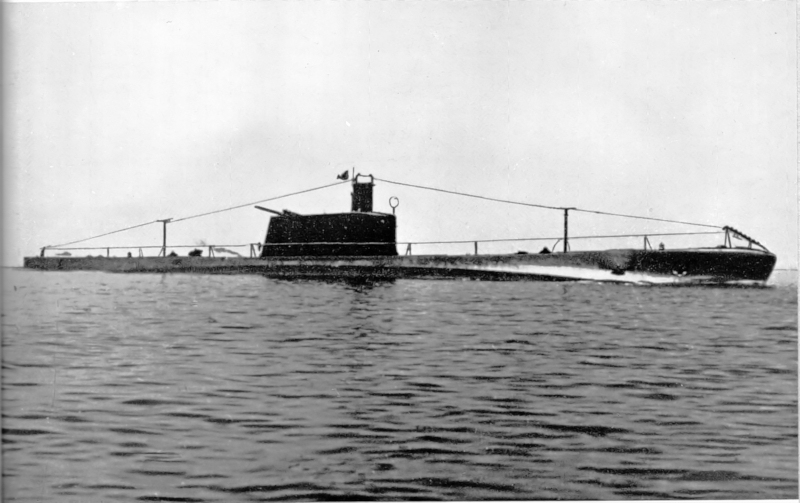 Air War over Europe Air War over Europe During the day, RAF Bomber Command dispatches five Wellingtons to bomb Essen but they return due to lack of cloud cover. United States The government creates the War Relocation Authority to "Take all people of Japanese descent into custody, surround them with troops, prevent them from buying land, and return them to their former homes at the close of the war." As a result, 120,000 men, women, and children were rounded up on the West Coast. Three categories of internees were created: Nisei (native U.S. citizens of Japanese immigrant parents), Issei (Japanese immigrants), and Kibei (native U.S. citizens educated largely in Japan). The internees were transported to one of ten relocation centers in California, Utah, Arkansas, Arizona, Idaho, Colorado, and Wyoming. One Japanese American, Gordon Hirabayashi, fought internment all the way to the Supreme Court. He argued that the Army, responsible for effecting the relocations, had violated his rights as a U.S. citizen. The court ruled against him, citing the nation's right to protect itself against sabotage and invasion as sufficient justification for curtailing his and other Japanese Americans' constitutional rights. Pacific War AUSTRALIA The USAAF 9th Pursuit Squadron arrives at Darwin, Northern Territory, with P-40Es to provide air defense for the port. Shortly after 0001 hours at Del Monte Field on Mindanao Island, Philippine Islands, the two B-17 Flying Fortresses that picked up General Douglas MacArthur and his party, take off for the 1,500 miles flight to Darwin, Northern Territory. The General sits in the radio operator's seat, his chief of staff, Major General Richard K. Sutherland, squeezed into the bomb bay. Lieutenant Bostrom's overloaded B-17 staggers into the air with one engine spluttering. It is MacArthur's son's first airplane flight, and he is excited until turbulence renders him airsick. When the plane reaches Darwin, the city is under Japanese attack, and the aircraft are diverted to the emergency strip, Batchelor Field, 50 miles away. They deplane at 0900 hours, barely able to stand. MacArthur spots an American officer and asks him about the buildup to reconquer the Philippines. The officer says, "So far as I know, sir, there are very few troops here." Startled, MacArthur turns to Sutherland, and says, "Surely he is wrong." MacArthur and his party breakfast on canned peaches and baked beans. The General demands a motorcade to the nearest train station in Alice Springs, Northern Territory, 1,000 miles away because his wife is exhausted from air travel. But MacArthur's son, also exhausted is now on intravenous feeding. The doctors cannot guarantee "little Arthur will make it over a long desert drive without shelter or food." MacArthur and his party board two DC-3s borrowed from a local airline, and take off as a Japanese air raid is starting. They reach Alice Springs, which resembles an Old West town replete with saloon, wooden boardwalks, and flies, without further incident. MacArthur watches a double feature at the local movie theater, his first film since leaving Manila, and the party sleeps on cots on the hotel's verandah. YouTube (General MacArthur In Australia)SOUTHWEST PACIFIC AREA (5th Air Force): General Douglas MacArthur arrives in Australia to assume command of United Nations forces in the SWPA. He actually assumed command on 18 Apr. 8th Bombardment Squadron, 3d BG, transfers from Brisbane to Charters Towers with A-20's; first mission is 1 Apr. 9th Pursuit Squadron, 49th Pursuit Group transfers from Williamstown to Darwin, Australia with P-40's; first mission is 18 Mar. INDIA Air Vice Marshal Donald F. Stevenson, commanding Allied air forces, moves HQ from Burma to Calcutta. India. PACIFIC Submarine USS Grayback sinks a Japanese collier 6 miles west of Port Lloyd, Chichi Jima, Bonin Islands. PHILIPPINE ISLANDS The submarine USS Permit, which was originally scheduled to evacuate General Douglas MacArthur and party from Corregidor, is damaged by depth charges off Tayabas Bay, Luzon, but remains on patrol.
|
|
lordroel
Administrator
Posts: 68,096 
Likes: 49,492
|
Post by lordroel on Mar 18, 2021 3:50:58 GMT
Day 921 of World War II, March 18th 1942Battle of the Atlantic Off Cape Hatteras, North Carolina, U-124 sinks Greek SS Kassandra Louloudis (all 35 survivors picked up by the US Coast Guard cutter USS Dione) and US tanker E.M. Clark (1 killed, 26 survivors in a lifeboat picked up by Venezuelan tanker Catatumbo, 14 survivors in another lifeboat picked up by US destroyer USS Dickerson). Battle of the Mediterranean2 miles off Brindisi, Italy, British submarine HMS Upholder sinks Italian submarine Tricheo which is traveling on the surface, breaks in 2 and sinks immediately (38 killed, the captain and 2 others survive). Pacific War AUSTRALIA On the day after General Douglas MacArthur arrived in Australia, the USAAF operational strength consists of about 213 combat aircraft, i.e., 12 B-17 Flying Fortresses, 27 A-24 Dauntless dive bombers, several miscellaneous light and medium bombers, 33 P-39 and 52 P-400 Airacobras, 92 P-40s and miscellaneous transport and other noncombat aircraft. Approximately 100 additional aircraft are being repaired or assembled. Very few of the fighter pilots are experienced or well trained and most of the bomber crews are exhausted and have low morale. In the morning, General Douglas MacArthur sends his staff officers by plane south from Alice Springs, Northern Territory, while he orders up a special train for himself and his family. Jean MacArthur will have no more flying. The MacArthurs board a three-car wooden train drawn by a steam locomotive, that scuttles down a narrow-gauge line. The train chugs off on a 70-hour journey down 1,028 miles of track to Adelaide, South Australia. BURMA Pilots of the 3rd Fighter Squadron, AVG attack a Japanese airfield near Moulmein at 0755 hours destroying three bombers, two transports and 11 fighters on the ground. CHINA USN river gunboat Tutuila, decommissioned at Chungking, China, on 18 January, is leased to the Chinese government for the duration of the war. NEW HEBRIDES U.S. Army troops, two companies of the 182rd Infantry and an engineer company, arrive on Efate Island to build an airfield. UNITED KINDOM Vice Admiral Lord Louis Mountbatten, Queen Victoria's grandson, is named Chief of Combined Operations. HAWAII Photo: View of new 20mm gun installations aboard the U.S. Navy aircraft carrier USS Enterprise (CV-6) at Pearl Harbor Naval Shipyard, Hawaii, on 19 March 1942. Note the destroyers USS Gridley (DD-380) and USS Fanning (DD-385) in the background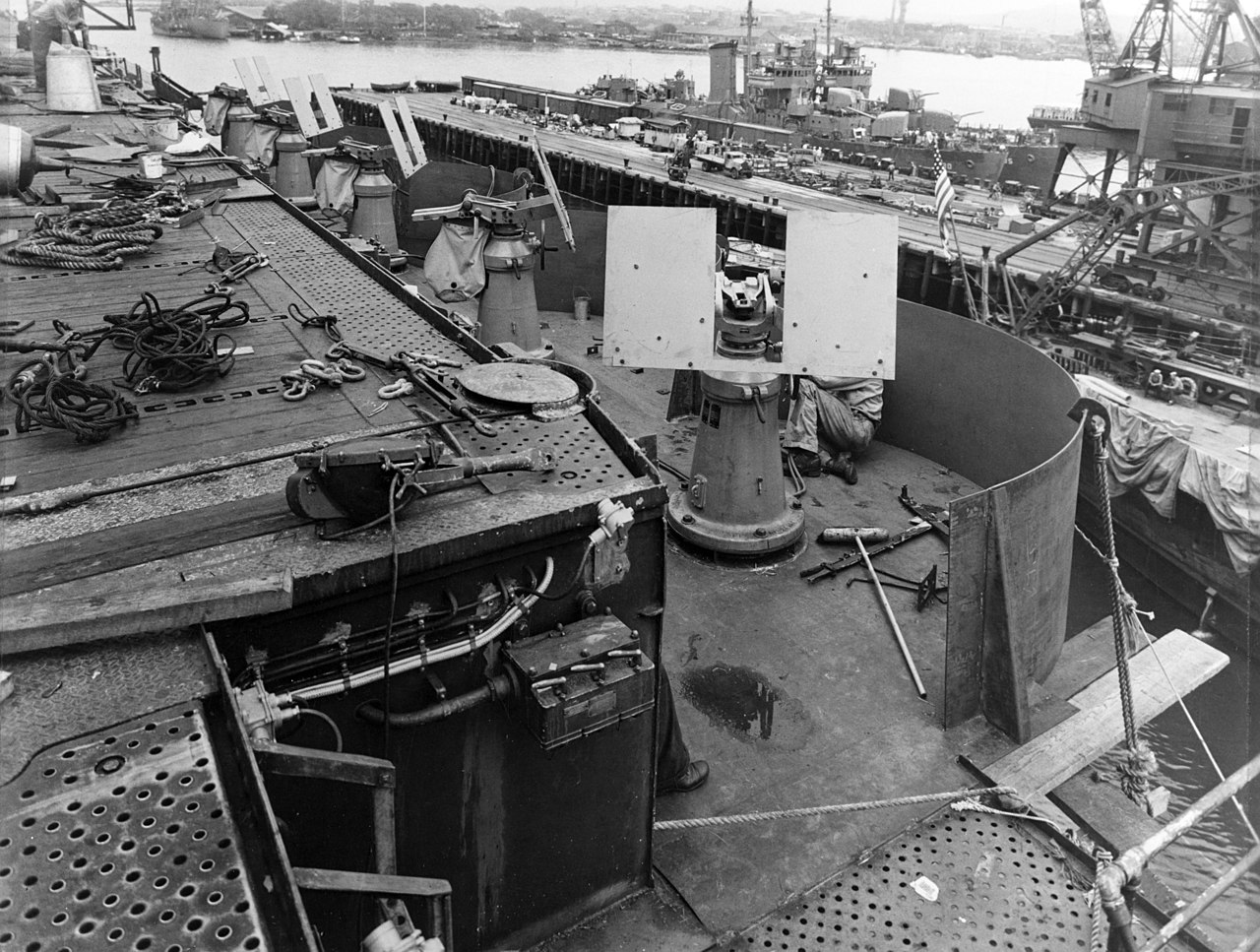
|
|
lordroel
Administrator
Posts: 68,096 
Likes: 49,492
|
Post by lordroel on Mar 19, 2021 2:53:40 GMT
Day 922 of World War II, March 19th 1942Eastern Front Siege of Leningrad Day 193 - 50 miles Southeast of Leningrad, Soviet 2nd Shock Army is surrounded on the Volkhov River. 2nd Shock Army’s breakthrough of the German line on January 18 has become a deep salient pointing Northwest from Spasskaya Polisk on the Volkhov River towards Leningrad but they have been unable to widen the gap in the German line. A German counterattack launched on March 15 now closes the door behind them. Battle of the Atlantic 25 miles South of Cape Fear, North Carolina, U-124 sinks US tanker Papoose (2 killed, 32 survivors picked up by US destroyer USS Stringham 10 hours later) and US tanker W.E. Hutton carrying 65,000 barrels of heating oil 13 killed, 23 survivors rescued 12 hours later by British merchant MV Port Halifax). 87 miles Northwest, U-332 sinks American SS Liberator carrying 11,000 tons of sulphur (5 killed by the explosion and sulphur fumes, 30 survivors in 2 lifeboats picked up by US fleet tug USS Umpqua). Air War over Europe During the day, RAF Bomber Command dispatches a Wellington to Essen but the aircraft returns early due to lack of cloud cover. Pacific War ALASKA Military Intelligence warns that a Japanese seizure of the Aleutian Islands, or a raid on Alaska, could be expected at any time. It is believed that the attack would be to prevent the U.S. from invading Japan from the north, or to obstruct Soviet/American communications. AUSTRALIA General Douglas MacArthur and his party endure traveling in a tiny railroad coach with two hard wooden seats running lengthwise. The second car is a diner with a long wooden table, washtubs full of ice, and an Australian army stove. Two Australian sergeants and an army nurse do the housekeeping. To switch from diner to passenger car, the train has to stop, and passengers have to get out of one car and walk along the ground to the other. MacArthur and his families sit in the car, besieged by flies. MacArthur goes to sleep. At one point, the engineer stops the train, surrounded by sheep ranchers. The general thinks they want a speech from the war hero but actually they want a doctor to assist one of the ranchers; after the surgery, the train leaves. BURMA Lieutenant General William J. Slim, former General Officer Commanding 10th Indian Division in Syria, arrives in Burma to take command of Imperial troops, now formed into the Burma I Corps. In the Sittang Valley, Japanese troops attack Toungoo, the original training base of the American Volunteer Group. General Slim aims to hold the Japanese on the Prome-Toungoo line, blocking two roads. Between the roads is 80 miles of jungle and hills, with no connecting roads. Two Chinese armies move to Toungoo to block that route. While Chinese divisions are the strength of British brigades, they are good troops with years of experience in fighting the Japanese. However, their top leader, Generalissimo Chiang Kai-Shek, more concerned with fighting rival Communist leader Mao Zedong (Mao Tse-Tung), is reluctant to commit his troops. And communications between Slim and the American commanding the Chinese troops, Lieutenant General Jospeh Stilwell, are slow and complicated. British forces are in poor shape, too, demoralized and in retreat. The 17th Division has been on the run, and 1st Burmese is untested. Slim's HQ's radio batteries have to be recharged by operating a pedal-driven generator. Slim has one trump card, though, the 7th Armoured Brigade, superior to the tankless Japanese. Map: Japanese advance, January–March 1942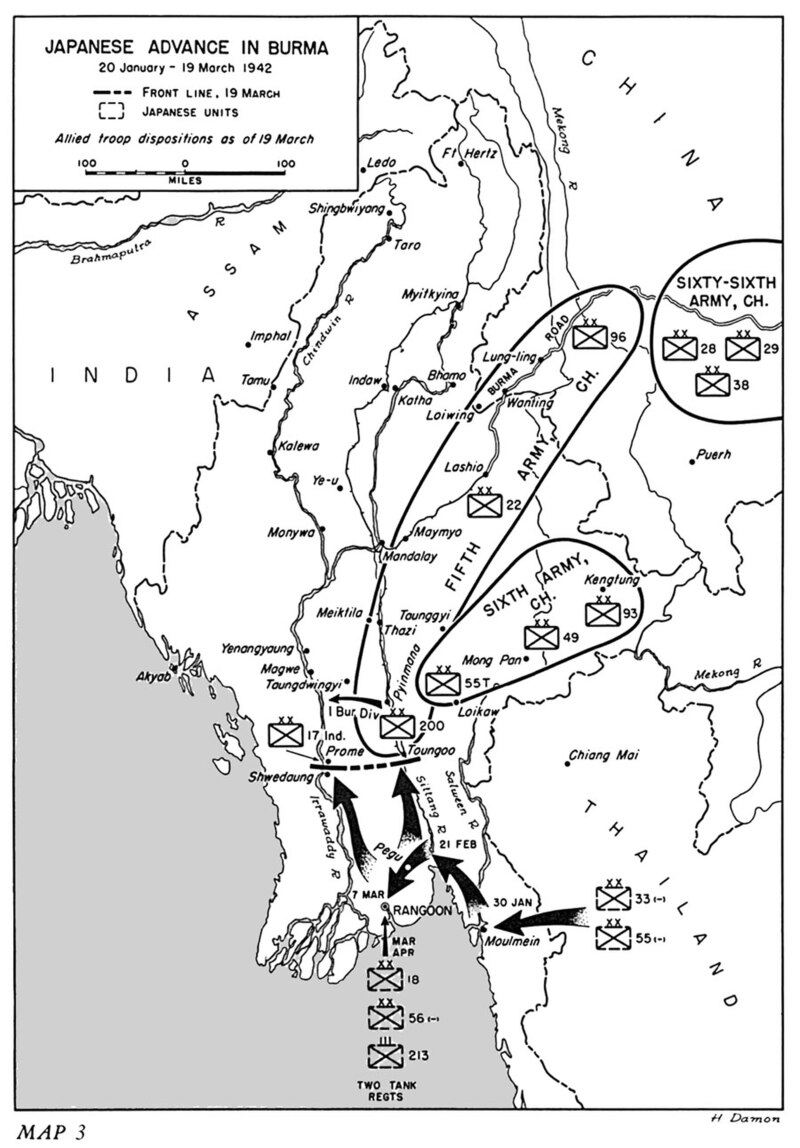 FIJI ISLANDS Japanese submarine I-25 launches a Yokosuka E14Y1,"Glen" to reconnoiter Suva on Vitu Levu Island. PHILIPPINE ISLANDS Philippine President Manuel Quezon and 13 members of his party are transported from Dumaguete, Negros Island, to Oroquieta, Mindanao Island, after a 240-mile voyage in motor torpedo boat PT-41.
|
|
lordroel
Administrator
Posts: 68,096 
Likes: 49,492
|
Post by lordroel on Mar 20, 2021 14:38:32 GMT
Day 923 of World War II, March 20th 1942YouTube (Crap Tactics in the Pacific - Shall MacArthur Return?)Eastern FrontThe Soviet offensive at Kerch in the Crimea is defeated by the Germans with heavy losses to the Soviets. Battle of the AtlanticU-71 sinks US steamer Oakmar (carrying Manganese ore, burlap and rubber from Calcutta, India) just 450 miles short of its destination in Boston (6 killed, 30 survivors in 1 lifeboat picked up by Greek SS Stavros on March 22). Battle of the MediterraneanThe Second Battle of Sirte - Four merchant ships carrying 26,000 tons of supplies sail from Alexandria at dawn for Malta, to supply food and munitions to the besieged island. Its escort, commanded by Rear Admiral Sir Phillip Vian, consisting of five light cruisers HMS 'Cleopatra', 'Dido', 'Euryalus' and 'Penelope', the antiaircraft light cruiser HMS 'Carlisle' and 18 destroyers faces opposition from the entire Italian Mediterranean Fleet. The sailing is reported to Axis forces by spies. Heavy air attacks on Malta begin as Axis forces hope to eliminate the island as useful British base of operations in the central Mediterranean Sea. Photo: Bomb damage to the motor transport depot of 32nd Company, Royal Army Service Corps at Floriana, 20 March 1942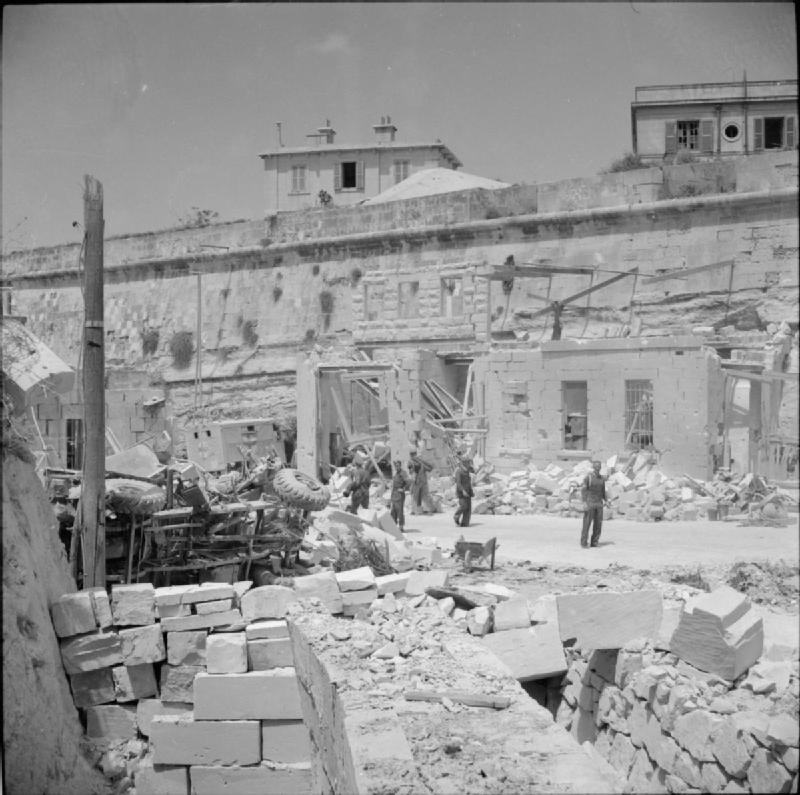 Western Desert Campaign Western Desert CampaignComplying with the request of 8 March for offensive action to divert the enemy's attention from a Malta-bound convoy, the British Eighth Army raids landing grounds in the Derna and Benghazi areas after nightfall. Air War over EuropeRAF Bomber Command dispatches 13 Manchesters and six Lancasters on daylight minelaying in the Frisian Islands; only 11 aircraft reached the correct area. Two Wellingtons on a mission to Essen returned because of lack of cloud. There are no losses. A report submitted by Major General Ira C Eaker in compliance with Major General James E Chaney's instructions of 25 February indicates completion of studies of RAF Bomber Command operations and of airfields, training, tactical doctrine, equipment, and methods of conducting air offensive in cooperation with the RAF. The report also indicates much dependence upon the British for the present but emphasizes the apparent compatibility of the tactical doctrines of the US (daylight precision bombing) and RAF (night area bombing), and implies the principle of coordinating these attacks to complement each other. United StatesThe "Plan for Initiation of U.S. Army Bombardment Operations in the British Isles" further elaborates previous USAAF plans outlining the intention of launching strategic bombardment from the U.K. against facilities supporting German national, economic, and industrial structure. The South Dakota Class battleship, USS 'South Dakota' (BB-57), is commissioned at Philadelphia, Pennsylvania. Photo: USS Grunion (SS-216), 20 March 1942 at the Electric Boat Co., Groton, CT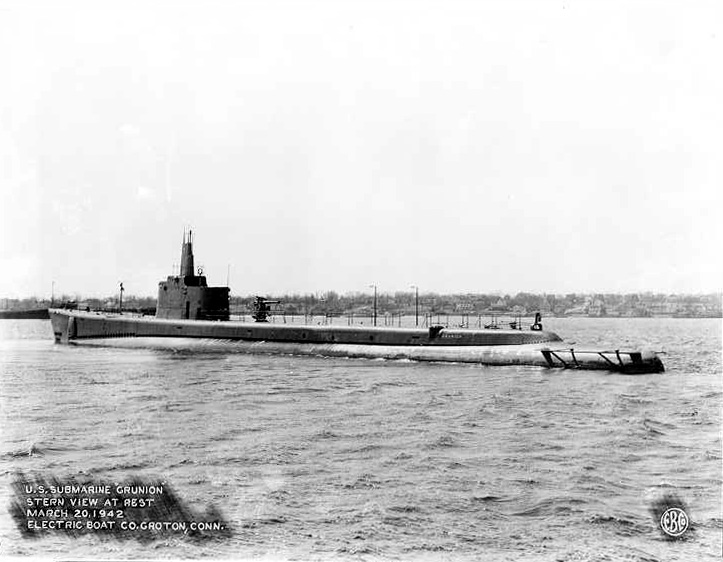 Pacific War Pacific War AUSTRALIA Japanese "Betty" medium bombers, attack the Broome Airfield, Western Australia, at high altitude. There are a number of craters off the end of the strip and in the tidal flats; one aboriginal is killed by a bomb splinter but no other casualties or damage was caused. BURMA Japanese troops, reinforced by the 18th and 56th Division which had arrived by sea at Rangoon a few days earlier, attack the Chinese 6th Army near Toungoo. Photo: "Burma. 20 March 1942. General Sir Archibald Wavell (right) is greeted by General T. J. Hutton, General Officer Commanding in Chief of Burma, upon his arrival at an RAF airfield" PHILIPPINE ISLANDS Major General Jonathan Wainwright learns that he has been promoted to the rank of Lieutenant General and that Washington has placed him in command of all U.S. Forces in the Philippines (USFIP).
|
|
lordroel
Administrator
Posts: 68,096 
Likes: 49,492
|
Post by lordroel on Mar 21, 2021 7:21:06 GMT
Day 924 of World War II, March 21st 1942Eastern Front In the northern sector south of Lake Ilmen, four divisions of the German 16th Army entrapped at Demyansk begin attempts to break out. The winter thaw holds them up and it is not until 21 April that the four divisions make contact with German troops. Photo: Sergeant gives soldier food, right: wounded with head and arm injuries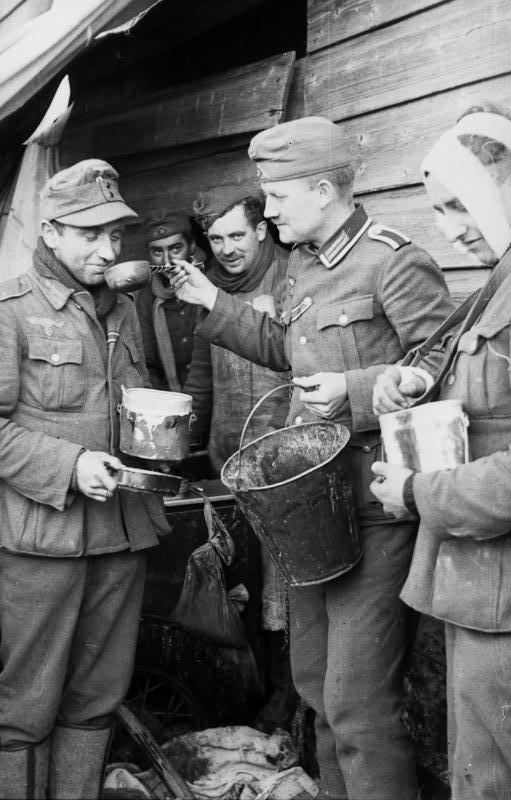 Battle of the Mediterranean Battle of the MediterraneanThe Second Battle of Sirte - The Axis, now aware of the British supply convoy sailing from Alexandria, Egypt, to Malta, dispatch Vice Admiral Angelo Iachino from Taranto with the battleship 'Littorio' and four destroyers; Rear-Admiral Angelo Parona also sets sail from Messina with the heavy cruisers 'Gorizia' and 'Trento', the light cruiser 'Bande Nere' and four destroyers. Western Desert CampaignThe British Eighth Army continues raids on forward landing grounds of Axis forces as a diversion for a convoy to Malta. The raids are partially successful drawing off part of the enemy's aircraft. Photo: A lorry passes by a sign that warns of the danger of low-flying enemy aircraft in the Western Desert, 22 March 1942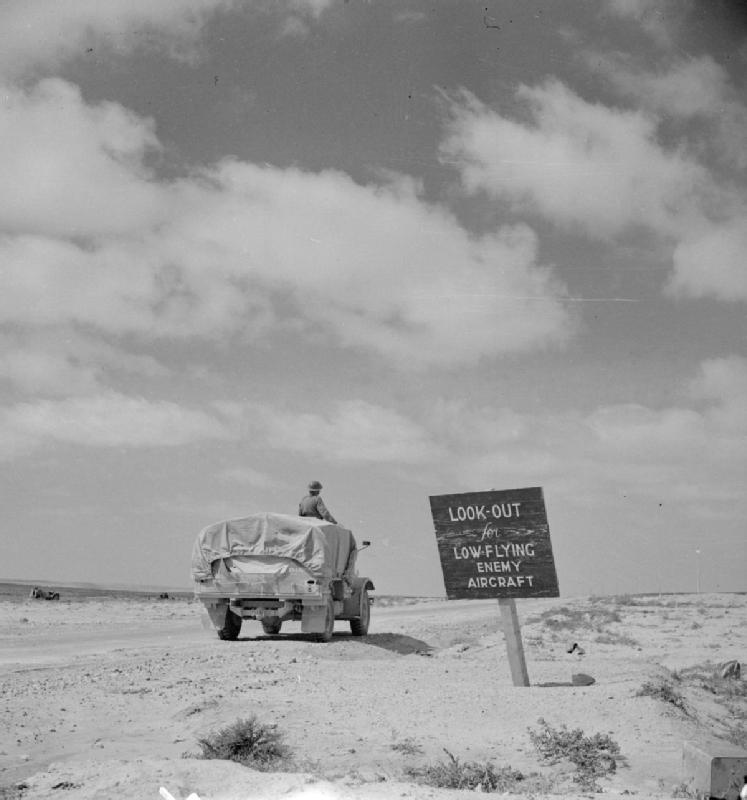 Pacific War Pacific War AUSTRALIA Late in the afternoon, General Douglas MacArthur's train reaches Kooringa, 80 miles north of Adelaide, South Australia. One of his staff officers, Colonel Dick Marshall, who had been sent on ahead, boards the train and tells the general that there are fewer than 32,000 Allied troops, American, British, and Australian, in the whole country, most of them service forces. There is not a single tank in the nation and the only combat-ready force is one brigade of the Australian 6th Division. If the Japanese land, the Australians intend to withdraw to the "Brisbane Line," holding the settled southern and eastern coasts, abandoning the northern ports to the Japanese. Supply lines to the rest of the Allied world, committed to defeating Germany first, are long. "God have mercy on us," MacArthur whispers. It is, he writes, his greatest shock and surprise of the whole war. In Adelaide, MacArthur swaps his little train for a luxurious private car provided by Australia's commissioner of railways. The press is there to greet him and seek a statement. MacArthur scrawls on the back of an envelope, "The President of the United States ordered me to break through the Japanese lines ...for the purpose, as I understand it, of organizing the American offensive against Japan, a primary object of which is the relief of the Philippines. I came through and I shall return." A single Mitsubishi Ki-15, Army Type 97 Command Reconnaissance Plane (later assigned the Allied Code Name "Babs") takes off from Koepang, Timor, to reconnoiter the defenses of Darwin, Northern Territory, in readiness for a larger strike force of Mitsubishi G4M, Navy "Betty" bombers. Coast watchers on Bathurst Island notify Darwin of the approaching reconnaissance aircraft at about 1200 hours and it is shot down by USAAF P-40 pilots of the 9th Pursuit Squadron. As anticipated, the Japanese bombers make a raid that same day but not on Darwin. They fly 200 miles further southeast and bomb Katherine, Northern Territory. They presumably were hoping to find Allied bombers at the Katherine Airfield but none were there and damage at the airfield is minimal. BURMA The Burma 1st Division, upon being relieved on the Toungoo front by the Chinese 200th Division, Chinese 5th Army, begins a movement to the Irrawaddy front, leaving a large area south of Toungoo undefended. Lieutenant General Joseph Stilwell, Commanding General American Army Forces, China, Burma and India and Chief of Staff of the Chinese Army, now in Burma, issues orders for Chinese participation in the defense of the line Toungoo-Prome. The Chinese 5th Army is charged with the defense of Toungoo; its 200th Division is reinforced by attachment of the Temporary 55th Division (T-55th ) of the Chinese 6th Army, which is to move to Pyawbwe. In army reserve, the Chinese 22d Division is directed to Taungdwingyi, where it is to be prepared to assist the British in the Prome area while the Chinese 96th Division is to move to Mandalay. Japanese bombers and fighters open as 24-hour operation against Magwe Airdrome. Pilots of the 3d Fighter Squadron, AVG shoot down two "Nate's" at 1430 hours. The Japanese attack the airfield and destroy nine RAF Blenheim Mk. IV bombers and three AVG P-40s on the ground and three RAF Hurricane Mk. IIs in the air. INDIA The Assam-Burma-China Ferry Command is activated. It consists of 25 Pan-American World Airways DC-3 transports, which are soon diverted from mission of taking supplies to China in order to supply forces withdrawing from Burma. JAPAN In THE JAPAN TIMES newspaper, Rear Admiral SOSA Tanetsuga warns the Japanese people of American bases in Alaska and the Aleutians that could threaten the Homeland. NEW GUINEA The first four Curtiss Kittyhawks Mk. IAs of RAAF No. 75 Squadron arrive at Seven Mile Airdrome at Port Moresby. As they fly over the airdrome, they are fired on by anti-aircraft which damages three of the four aircraft; one never flies again. The remainder of the squadron arrives two hours later. PHILIPPINE ISLANDS Lieutenant General Jonathan Wainwright, as commander of U.S. Forces in the Philippines (USFIP), which supersedes U.S. Army Forces, Far East (USAFFE), establishes headquarters on Corregidor Island and appoints Major General Lewis Beebe his chief of staff. Major General Edward P. King, Jr., is named commander of Luzon Force.
|
|
lordroel
Administrator
Posts: 68,096 
Likes: 49,492
|
Post by lordroel on Mar 22, 2021 3:46:51 GMT
Day 925 of World War II, March 22nd 1942Eastern FrontAiming to link up with the German breakout from Demyansk, German troops attack Soviet 11th Army and 1st Shock Army at Staraya Russa. Germans begin mass exterminations of Jews at Auschwitz concentration camp, Poland, by dropping Zyklon B pellets, generating cyanide gas, into bunkers crowded with 800 - 1,200 Jews. Photo: German forces near Demyansk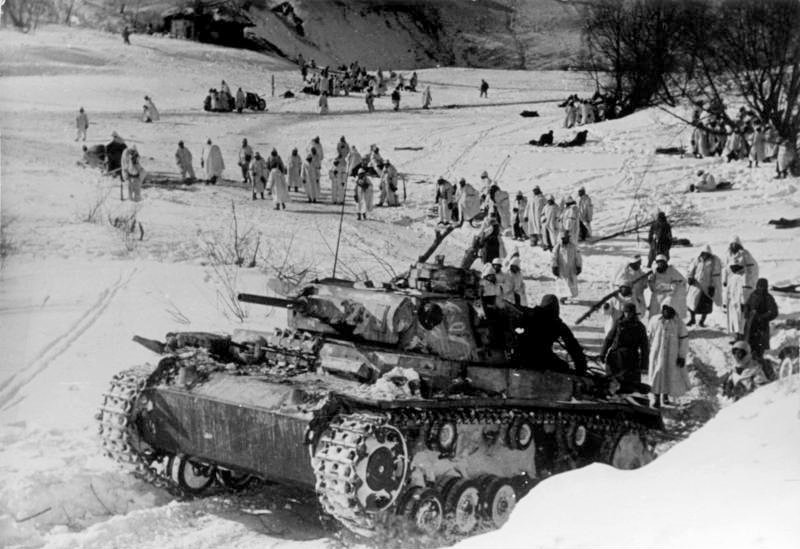 Battle of the Atlantic Battle of the Atlantic300 miles East of Atlantic City, New Jersey, U-373 sinks British MV Thursobank (30 killed, 22 Chinese crew and 4 British officers picked up after 3 days by Norwegian tanker MV Havsten). The Chinese crew will be arrested for mutiny after throwing away their oars and refusing to share food and clothing with the British officers. 200 miles further East, U-123 sinks US tanker Muskogee (all 34 hands lost). Battle of the Mediterranean2nd Battle of Sirte - 1 Italian battleship, 3 cruisers and 10 destroyers intercept British convoy MW10 in the Gulf of Sirte (halfway between Benghazi, Libya, and Malta). 4 British cruisers and 17 destroyers fend off the superior firepower of the Italian ships, while the 4 freighters escape under cover of a smokescreen. In the exchange of shellfire and torpedoes lasting until 7 PM, Royal Navy has 3 cruisers and 6 destroyers damaged (39 killed) while Italian battleship Littorio is slightly damaged. The battle is interrupted by a gathering storm which sinks Italian destroyers Lanciere (201 killed, 5 survivors) and Scirocco (189 killed, 2 survivors). Photo: British cruisers Cleopatra (making smoke) and Euryalus (foreground) moving into action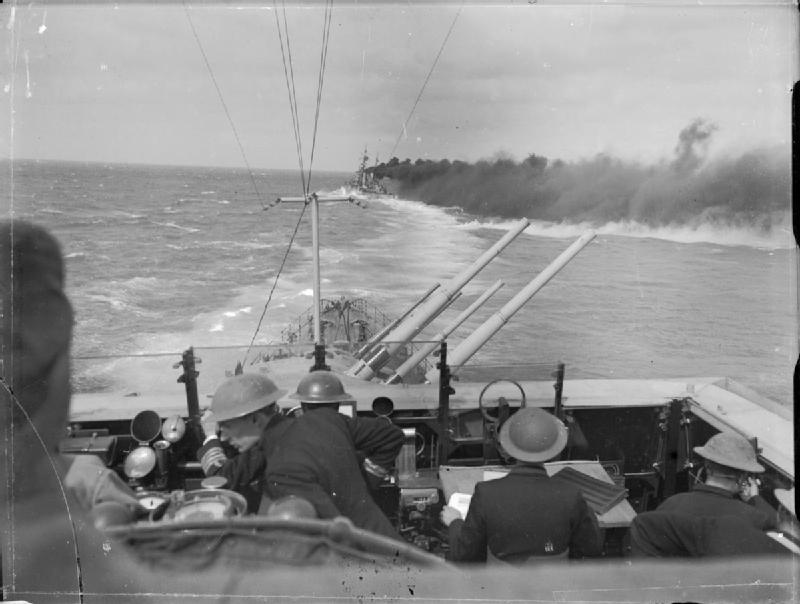 50 miles Northwest of Derna, Libya, an RAF Blenheim (203 Squadron) spots U-73 on the surface and drops four 250lb anti-submarine bombs. U-73 is severely damaged and forced to abort the patrol. Pacific War NEW GUINEA 9 Australian RAAF Curtiss P-40 Kittyhawks take off from Port Moseby to strafe the Japanese airfield at Lae. They destroy 14 aircraft (9 fighters and 3 bombers) out of 26 standing on the airfield and 2 Zero fighter patrolling the skies above (1 P-40 shot down). BURMA At dawn, Chinese troops (600th Regiment, 200th Division) ambush Japanese 122nd Regiment (55th Division) advancing into Oktwin. Japanese attempt to flank the Chinese positions but are pushed back by counterattacks. LUZON,PHILIPPINES Following the arrival of 60 twin-engine bombers from Malaya, Japanese bomb US artillery batteries, supply depots and command centers on Bataan and Corregidor, including night bombing. Americans correctly assume this is softening up for a renewed Japanese ground offensive. HAWAII Photo: The U.S. Navy aircraft carrier USS Enterprise (CV-6) moored at Ford Island, Pearl Harbor, circa in March 1942. Note the hulks of the destroyers USS Cassin (DD-372) and USS Downes (DD-375) in the left background
|
|
lordroel
Administrator
Posts: 68,096 
Likes: 49,492
|
Post by lordroel on Mar 23, 2021 3:47:12 GMT
Day 926 of World War II, March 23rd 1942Battle of the Atlantic65 miles Southeast of Cape Fear, North Carolina, U-124 torpedoes US tanker Naeco which is carrying 72,000 barrels of kerosene and 25,000 barrels of heating oil. Naeco explodes and breaks in two (24 dead, 14 survivors). 50 miles South of Newfoundland, U-754 sinks British tanker MV British Prudence (3 killed, 42 crew and 5 gunners were picked up by British destroyer HMS Witherington). After dark 680 miles Southeast of Bermuda, Italian submarine Morosini sinks British tanker Peder Bogen with 2 torpedoes and 70 rounds from the deck gun (all 53 hands rescued). German armed merchant cruiser Thor has been in the South Atlantic Ocean since February 25, searching unsuccessfully for whaling ships. Thor stops Greek freighter SS Pagasitikos (carrying coal to Montevideo, Uruguay) with a shot across the bows. SS Pagasitikos is sunk with a torpedo after all 33 crew, including 1 woman, are taken off. Battle of the MediterraneanIn the aftermath of 2nd Battle of Sirte, convoy MW10 does not arrive at Malta overnight as planned and is still at sea at daybreak. The 4 British transport ships are attacked by German bombers, sinking Clan Campbell and badly damaging Breconshire (which is beached). British destroyer HMS Southwold hits a mine and sinks (6 killed, 80 survivors rescued by destroyer HMS Dulverton) while assisting Breconshire. Freighters Pampas and Talabot reach Malta and begin unloading their cargo. Photo: Cruiser tanks and a 40mm Bofors anti-aircraft gun being unloaded from a ship in Grand Harbour, 24 March 1942 Air War over Europe Air War over Europe During the night of the 23rd/24th, RAF Bomber Command dispatches 12 Hampdens, three Stirlings and two Manchesters on a minelaying mission off Lorient without loss. This was the first time that Stirlings of No. 3 Group participated in the minelaying campaign. Pacific War ALEUTIAN ISLANDS Army aviation engineers begin work on the secret Otter Point Airfield on the 675 square mile Umnak Island separated from Unalaska Island, site of NavalOperating Base Dutch Harbor and Fort Mears, by Unmak Pass. By the end of the month, a 100 by 5,000 foot runway has been completed using Marston matting. Photo: Cape Field, later Fort Glenn Army Air Base, was secretly built at Otter Point on Umnak Island in 1942 ANDAMAN ISLANDS The Japanese invade these islands in the eastern part of the Bay of Bengal without opposition. PHILIPPINE ISLANDS On Bataan, American and Filipino troops dig in for the next round. The I Corps fields 32,000 men and 50 guns on the west, while II Corps has 28,000 men and about 100 guns on the east, including 31 naval guns up to 3-inch. Troops have been trained in jungle warfare, trenches and dugouts built, mines laid, and a 12-foot palisade of bamboo erected across the front. The Japanese are having ration trouble, too, as the 14th Army has cut rations from 62 ounces to 23; about 13,000 Japanese troops are in the hospital. But General HOMMA Masaharu, commanding the Japanese 14th Army, enjoys an edge: two Army bomber regiments comprising 60 heavy bombers, plus naval air force units. Homma plans to seize the dominant Mount Samat, centerpiece of the American line, then drive southeast to Limay, ringing the mountains to turn west towards Mariveles, the peninsula's base. The attack will be led by the newly-arrived 4th Division and the 65th Brigade. Meanwhile, Japanese aircraft drop beer cans tied with ribbons, asking Wainwright to surrender. The appeal is ignored. HAWAII Photo: close-up view of the aft of the island aboard the U.S. Navy aircraft carrier USS Enterprise (CV-6), taken at Pearl Harbor (Ford Island), note the Mark 33 gun director and the 1.1"/75 caliber guns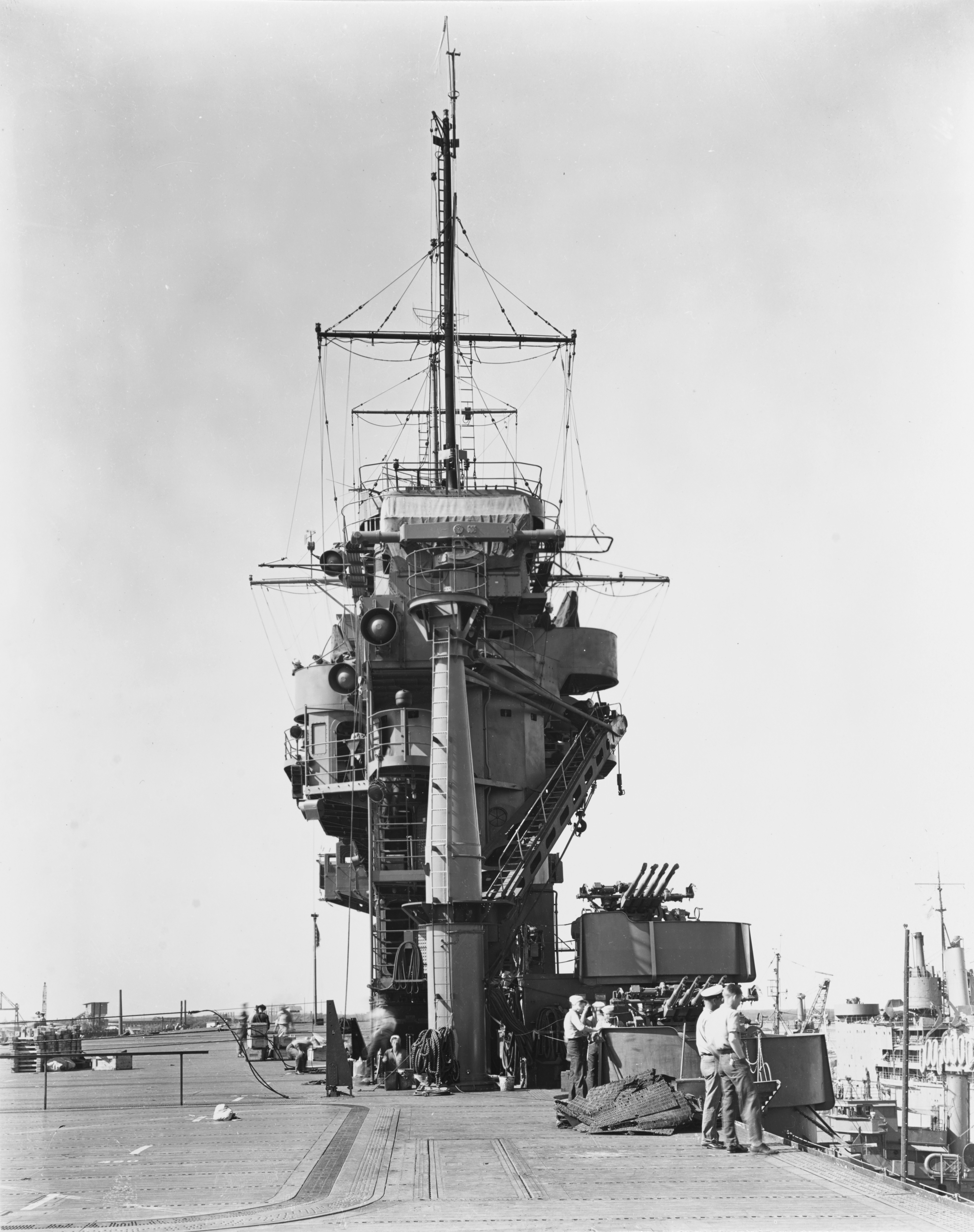
|
|
lordroel
Administrator
Posts: 68,096 
Likes: 49,492
|
Post by lordroel on Mar 24, 2021 3:47:41 GMT
Day 927 of World War II, March 24th 1942Air War over Europe 18 RAF Douglas A-20/DB-7 Boston light bombers mount daylight raid on targets in Northern France near the Channel coast with Spitfire fighter support. 12 Bostons bomb the power station at Comines and another 6 Bostons bomb railway yards at Abbeville. Battle of the Atlantic Barents Sea - British minesweeper HMS Sharpshooter (escorting convoy QP9 160 miles North of Norway) spots U-655 on the surface nearby, then rams and sinks U-655 (all 45 hands lost). U-585 is damaged by depth charges from 3 Allied warships in the Barents Sea and forced to return to base at Kirkenes. Overnight, British minesweeping whaler HMS Sulla is lost in a gale in the Norwegian Sea en route for delivery to USSR in convoy PQ-13. Photo: HMS Sharpshooter in 1938
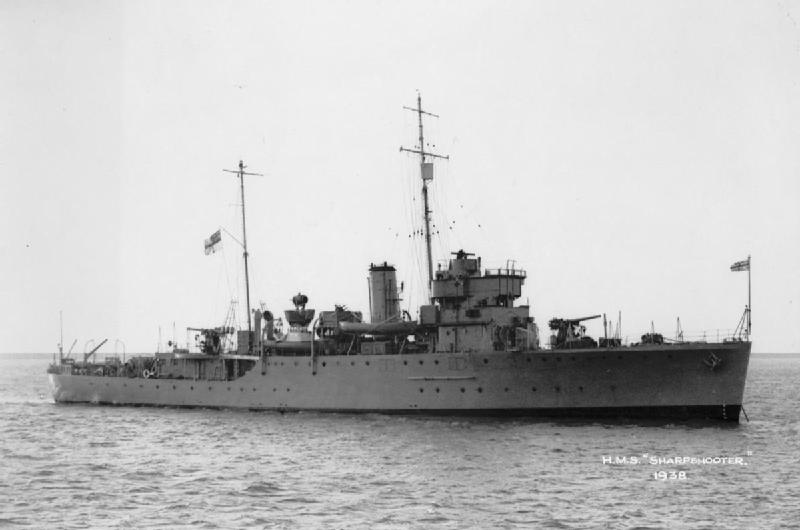 Battle of the Mediterranean Battle of the MediterraneanGerman bombers return to Malta to finish off British ships in convoy MW10. British destroyer HMS Legion is damaged by near misses and beached. Photo: A British Light Tank Mk VI, wearing distinctive camouflage, on a firing range on Malta, 24 March 1942 Battle of the Caribbean Battle of the Caribbean 365 miles North of Bermuda, U-123 attacks British tanker MV Empire Steel with torpedoes and the deck gun. Empire Steel, carrying 11,000 tons of aviation spirit and kerosene from the Gulf of Mexico to Britain, explodes and sinks (35 crew and 4 gunners lost, 7 crew and 1 gunner picked up by American tug Edmund J. Moran and landed at Norfolk, Virginia). Air War over Europe During the day, 18 RAF Bomber Command Bostons are dispatched on two escorted raids: 12 aircraft hit the Comines power-station and six bomb the marshaling yard at Abbeville. Bombing results were not observed; no aircraft are lost. During the night of the 24th/25th, 35 aircraft of RAF Bomber Command lay mines off Lorient; a Hampden and a Lancaster are lost. These were the first Bomber Command losses for 11 days and nights and the Lancaster lost, from 44 (Rhodesia) Squadron, was the first of its type to be lost on operations. United KingdomPhoto: troops of the 1st Polish Corps marching across open country to take up a new position during an infiltration exercise near Glenfarg in Scotland United States United States The Pacific Theater of Operations is established as an area of U.S. responsibility by the Combined Chiefs of Staff. Photo: The U.S. Navy aircraft carrier USS Wasp (CV-7) in at anchor in Casco Bay, Maine (USA, with a motor launch coming alongside. The planes on deck, some with wings folded, include (circa) 15 Vought SB2U-3 Vindicator scout bombers, three Douglas TBD-1 Devastator torpedo bombers and 20 Grumman F4F-4 Wildcat fighters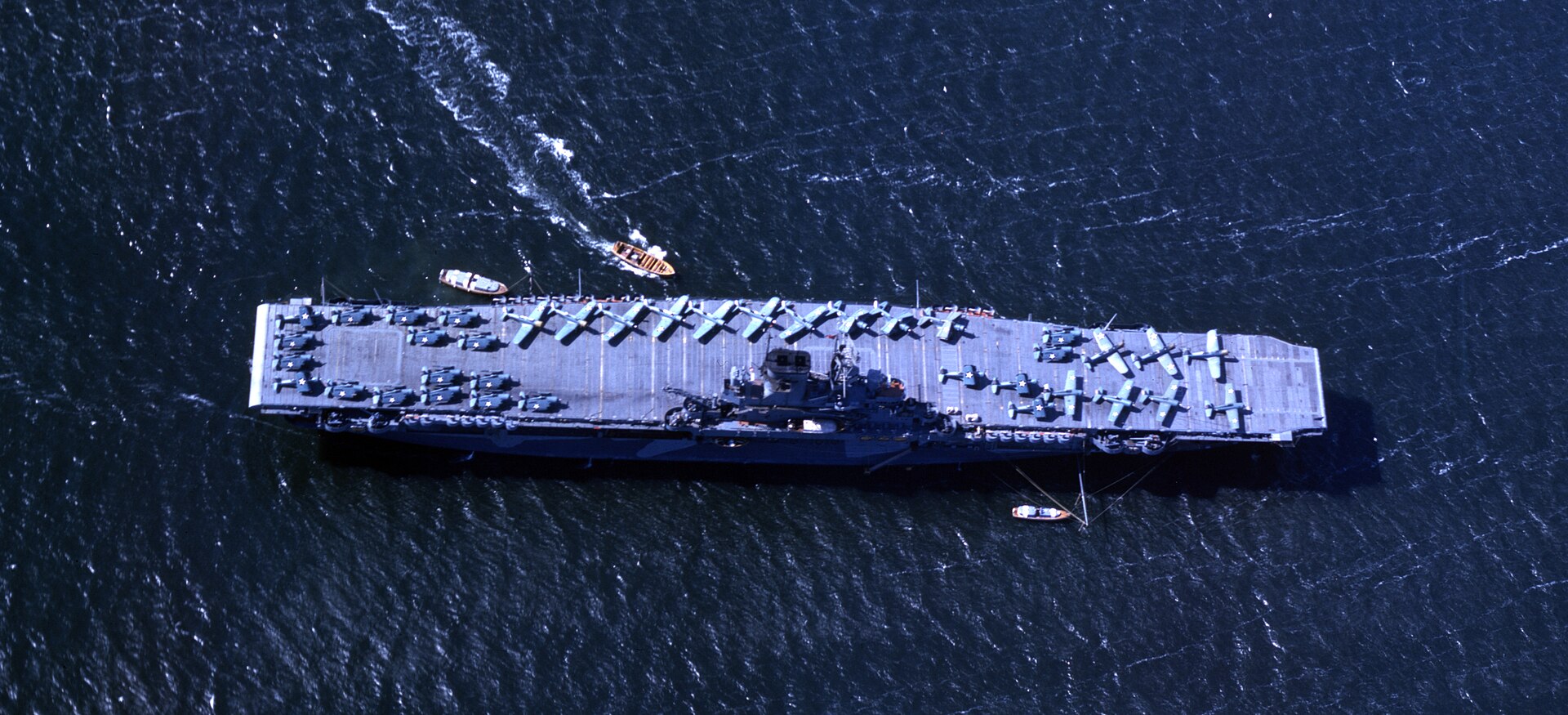 Photo: The U.S. Navy aircraft carrier USS Wasp (CV-7) in at anchor in Casco Bay, Maine (USA). The battleship USS North Carolina (BB-55) and USS Washington (BB-56) are anchored in the upper right. This was the only time these ships operated together. Wasp and Washington left the next day for Scapa Flow, Scotland (UK) Photo: The U.S. Navy aircraft carrier USS Wasp (CV-7) in at anchor in Casco Bay, Maine (USA). The battleship USS North Carolina (BB-55) and USS Washington (BB-56) are anchored in the upper right. This was the only time these ships operated together. Wasp and Washington left the next day for Scapa Flow, Scotland (UK)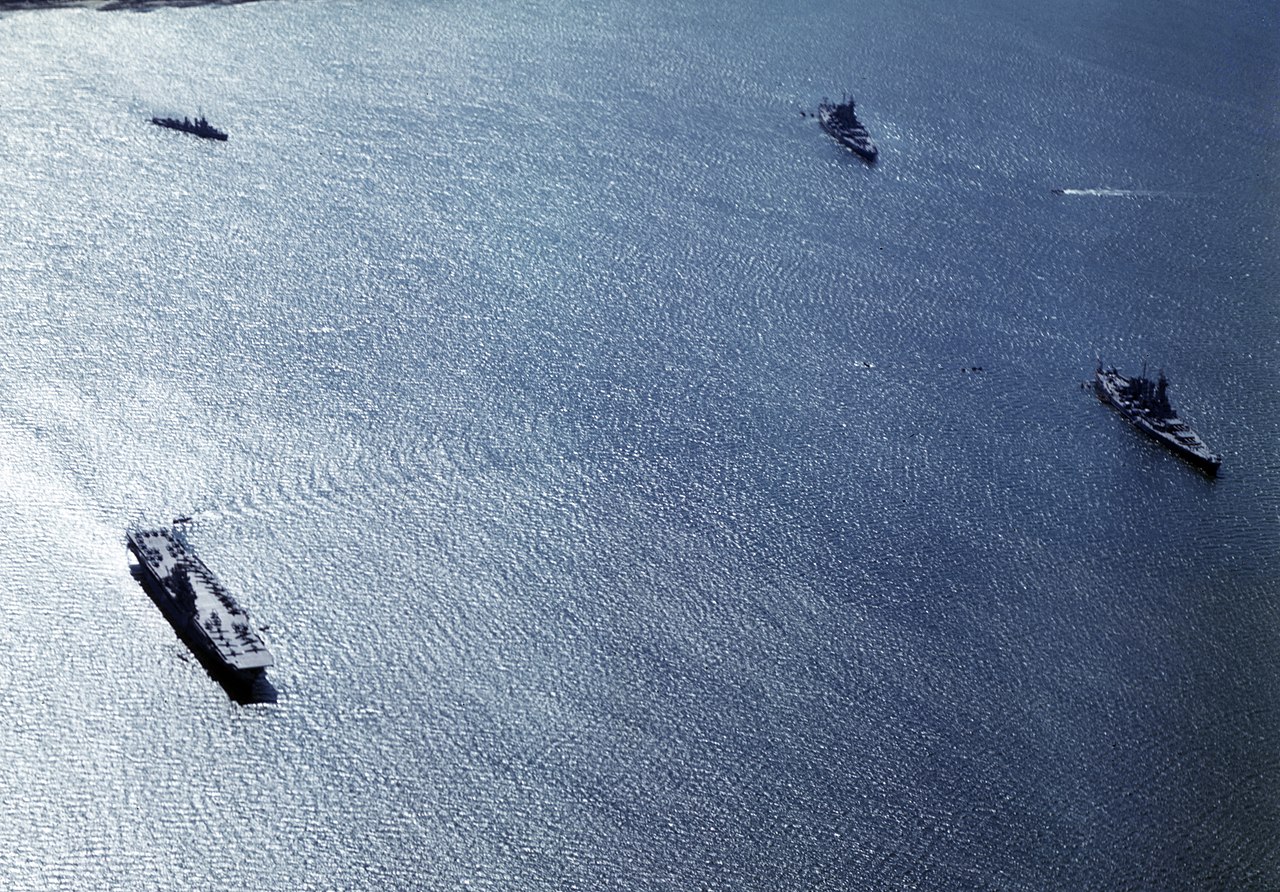 Pacific War Pacific War BURMA In a surprise attack on Kyungon Airfield, north of Toungoo, the Japanese rout the defenders (troops of Chinese 200th Division and rear elements of the Burma 1st Division) and cut the rail line and road, thus partially surrounding Toungoo. The Chinese fall back on Toungoo, while the Burmese succeed in withdrawing to the Irrawaddy front. CHINA British General Harold Alexander, General Officer Commanding Burma Army, and Generalissimo Chiang Kai-shek meet to discuss plans for the cooperation of Chinese and British Forces. PHILIPPINE ISLANDS The Japanese begin an intense air and artillery bombardment of Bataan. Luzon-based Japanese Army and Navy aircraft begin a thorough bombardment of Corregidor, continuing through the end of March. During this period night air attacks are conducted for the first time. A Filipino patrol on Bataan kills a Japanese officer who brought his documents with him to the front. They include orders for a reconnaissance in force on Mount Samat, followed by an attack on 26 March so the Americans dig trenches on Mount Samat. SOLOMON ISLANDS On Guadalcanal, now menaced by the Japanese, Australian coastwatcher Don McFarland heads for the isolated west coast community of Lavor with Martin Clemens and Ken Hay to set up a new observation post. THAILAND Ten P-40s of the 1st Fighter Squadron, AVG, based at Kunming Airdrome, China, and staging through Loiwing and Namsang, Burma, strafe Chiengmai Airdrome between 0710 and 0725 hours. Fifteen Japanese Army bombers are destroyed on the ground but two AVG P-40s are shot down by ground fire; one pilot is killed and the second is taken prisoner after evading capture for 28 days. PACIFIC OCEAN AREA (7th Air Force): 23d Bombardment Squadron (Heavy), 5th BG, transfers from Hickam Field to Mokuleia, Territory of Hawaii with B-17's and continues flying patrols. SOUTHWEST PACIFIC AREA (5th Air Force): Air echelon of 91st Bombardment Squadron, 27th BG, ceases operating from Brisbane, Australia and begins moving to Charters Towers with A-24s. Ground echelon is on Bataan.
|
|
lordroel
Administrator
Posts: 68,096 
Likes: 49,492
|
Post by lordroel on Mar 25, 2021 3:47:17 GMT
Day 928 of World War II, March 25th 1942Battle of the AtlanticThe destroyer USS 'Blakely' (DD-150) is torpedoed by German submarine 'U-156' off Martinique, French West Indies. The explosion carries away 60 feet (18 meters) of her bow. Six men are killed and 21 wounded, but the ship makes it to Port de France, Martinique, for emergency repairs. Photo: The heavily damaged USS Blakeley after the attack by U-156 German planes attack convoy PQ 16 as it proceeds toward Murmansk, USSR, from Reykjavik, Iceland; an armed U.S. freighter is damaged by near-misses and she leaves the convoy under tow of British trawler HMS 'Northern Spray' Photo: Allied tanker Dixie Arrow torpedoed in Atlantic Ocean by German submarine. Ship crumbling amidship under heat of fire, settles toward bottom of ocean, 1942 Battle of the Caribbean Battle of the Caribbean An unarmed U.S. freighter is torpedoed and shelled by German submarine 'U-103' about 75 miles WNW of Jamaica, and abandoned. 'U-103' surfaces and her commanding officer asks the Americans for the name and speed of their ship, and if all of her men have been accounted for, before he provides them with cigarettes. The freighter sinks early the following morning, after which time the U-boat departs. Air War over Europe During the night, RAF Bomber Command dispatches 254 aircraft, 192 Wellingtons, 26 Stirlings, 20 Manchesters, 9 Hampdens, 7 Lancasters, to attack Essen, the largest force sent to one target so far; 190 aircrew claim they hit the target many claiming hits on the Krupps works, but bombing photographs showed that much of the effort was drawn off by the decoy fire site at Rheinberg, 18 miles west of Essen. Essen's report says that only nine high-explosive bombs, 700 incendiaries and 1,627 leaflets were dropped there. One house was destroyed and two seriously damaged. Five people were killed and 11 injured. Nine aircraft, five Manchesters (out of the 20 dispatched), three Wellingtons, and a Hampden, are lost. Other targets bombed include Duisburg (by seven aircraft), Oberhausen (by two aircraft) while individual aircraft bomb Gladbeck and Hamborn. During the day, nine RAF Bomber Command Bostons, with fighter escort, carry out accurate bombing at Le Trait shipyard. No Bostons are lost. During the night of the 25th/26th, 26 of 27 aircraft dispatched bomb the port area at St. Nazaire, 38 aircraft dispatched lay mines off Lorient, 30 aircraft drop leaflets over France, and one bomber hits Lannion Airfield. One RAF Bomber Command aircraft dispatched on the night raid on Essen, Germany, bombs Haamstede Airfield. Pacific War AUSTRALIA An advanced flight echelon of B-26s assigned to the 22d BG (Medium) arrives at Archerfield Airdrome, Brisbane via the Pacific ferry route. General Douglas MacArthur finally consents to see Lt. General George Brett who commands all Allied air units in Australia. Brett later recalls, "MacArthur went into a dissertation on the air forces. It was evident that he had nothing but contempt and criticism for them. `They lack discipline, organization, purposeful intent,' he said." Brett's assessment is that the key to MacArthur's speech is that the Philippine campaign had been lost-but "through no fault of his." Jean MacArthur goes shopping in Melbourne, Victoria, to buy clothes, and finds out that most Australians have no idea of what they've been through. The Myer Emporium salesgirl looks her over, shakes her head sadly, and says, "SSW. Well, I don't know whether we've got anything." What does SSW mean? "Small-sized woman. They're hard to fit." Another shopper recognizes Mrs. MacArthur, and says, sympathetically, "Won't your clothes soon be arriving from Manila?" An advance air echelon of the USAAF 22d BG (Medium) equipped with B-26 Marauders arrives at Archefield Airdrome near Brisbane, Queensland, via the South Pacific ferry route. These are the first B-26s to reach an active war zone. The ground echelon has been in Australia for a month. NEW GUINEA On 21 March, RAAF No. 75 Squadron arrived at Seven Mile Aerodrome at Port Moresby with 17 Curtiss Kittyhawk Mk. IA (= USAAF P-40E) fighters. Today, only seven of the original aircraft are operational. SOUTHWEST PACIFIC AREA (5th Air Force): 16th and 17th Bombardment Squadrons , 27th Bombardment Group, cease operating from Brisbane with A-24s and begin moving to Charters Towers. PACIFIC Three Japanese merchant ships are sunk by U.S. submarines: (1) USS Drum sinks a cargo ship about 120 miles south southwest of Tokyo, Japan; (2) USS Pompano sinks a tanker about 70 miles NW of Naha, Okinawa; and (3) USS Tautog sinks a transport about 460 miles SE of Ulithi Atoll, Caroline Islands. SOCIETY ISLANDS The U.S. 162nd Infantry of the 41st Infantry Division, arrives at the 14 square mile Bora Bora Island in French Polynesia. Bora Bora Island is about 2,650 miles SSE of Honolulu, Territory of Hawaii. BURMA The Chinese 200th Division is virtually besieged in Toungoo. Elements of the Temporary 55th Division (T-55th) of the Chinese 6th Army, arrive north of the town but do not attack. The Burma I Corps is ordered to concentrate in the Prome-Allanmyo area. ALEUTIAN ISLANDS Japanese submarine I-9 launches a E14Y1, "Glen" , to reconnoiter Kiska and Amchitka Islands. MIDWAY ISLANDS Light cruiser USS St. Louis arrives and disembarks Companies "C" and "D," 2d Marine Raider Battalion, and a 37 mm gun battery of the 3d Defense Battalion.
|
|
lordroel
Administrator
Posts: 68,096 
Likes: 49,492
|
Post by lordroel on Mar 26, 2021 8:03:35 GMT
Day 929 of World War II, March 26th 1942Eastern Front Siege of Leningrad Day 200 - 350,000 – 460,000 civilians have died from cold, starvation and disease since the beginning of the siege. Many remain unburied, frozen in their homes. Lack of food causes some to resort to cannibalism either of frozen corpses or by hunting the living, often children. Battle of the Atlantic20 miles East of Cape Hatteras, North Carolina, U-71 sinks US tanker SS Dixie Arrow carrying 86,136 barrels of crude oil (11 killed, 22 survivors picked up by US destroyer USS Tarbell). 300 miles East of Cape Hatteras, U-123 hits US armed merchant cruiser (Q-ship) USS Atik with 2 torpedoes. USS Atik drops her disguise and returns 50-cal machinegun fire, killing Fähnrich zur See Rudi Holzer on U-123's bridge, and inaccurate shellfire. USS Atik’s crew abandon ship in lifeboats but all 141 are killed when USS Atik sinks detonating her primed depth charges. Operation Chariot - 3 destroyers and 16 small boats (motor torpedo boats and Fairmile B motor launches) leave Falmouth, Cornwall, for St Nazaire, France, carrying 346 Royal Navy sailors and 265 Commandos. HMS Campbeltown has 4.5 tons of explosives concreted into the bows to destroy the giant dry dock at St Nazaire to prevent their use by the large German warships. Photo: HMS Campbeltown being converted for the raid. There are twin lines of armour plate down each side of the ship and the Oerlikon mountings. Two of her funnels have been removed, with the remaining two cut at an angle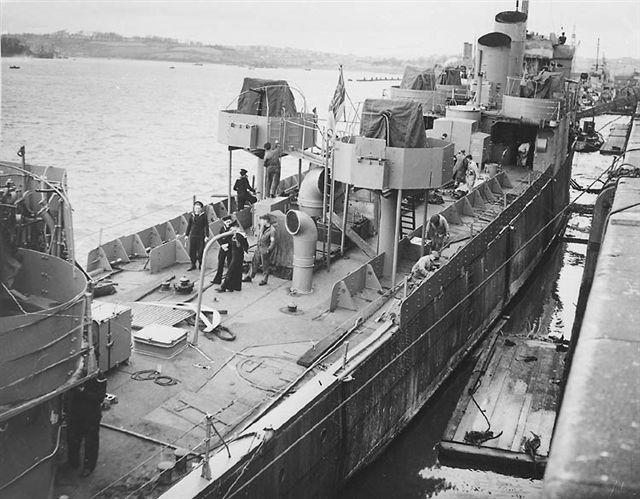 Rear Admiral John Wilcox commanding Task Force 39 with the battleship USS 'Washington' (BB-56), the aircraft carrier USS 'Wasp' (CV-7), the heavy cruisers USS 'Wichita' (CA-45) and 'Tuscaloosa' (CA-37) and six destroyers, sails from Portland, Maine, for Scapa Flow, the major British fleet base in the Orkney Islands. These ships will protect British home waters for the duration of Operation Ironclad -- the British invasion of Vichy French controlled Madagascar. This is a reflection of the heavy Allied losses in capital ships to Japanese action in the Pacific. Commander of the USN's Eastern Sea Frontier is given operational control of certain USAAF units for antisubmarine patrol duty in the Atlantic. Unity of command over Navy and USAAF units operating over water to protect shipping and conduct antisubmarine warfare is thus vested in the Navy. Battle of the MediterraneanAftermath of 2nd Battle of Sirte, Malta. In the Grand Harbour, German bombers sink freighters Pampas & Talabot (before their cargo are fully unloaded) and British destroyer HMS Legion which has been towed in following damage on March 24 (2 bombs hit, causing the forward magazine to explode, 11 killed). Despite camouflage British submarine HMS P39 which is undergoing repairs on the beach at Kalkara is also found by German bombers (P39 is badly damaged and will not return to service). 20 miles off Sidi Barani, Egypt, U-652 sinks HMS Jaguar (193 killed, 53 survivors picked up by HMS Klo while RHS Vasilissa Olga assists). U-205 takes advantage of the confusion and sinks the unescorted Slavol (36 killed, 20 survivors rescued by RHS Vasilissa Olga). Air War over Europe During the day, 20 of 24 RAF Bomber Command Boston attack the port area at Le Havre with the loss of one aircraft. Hits were reported on ships in the harbor. During the night of the 26th/27th, eight aircraft attack the port area at Le Havre. During the night of the 26th/27th, RAF Bomber Command dispatches 11 Blenheims on an intruder mission; five hit Schipol Airfield (with the loss of two) and individual aircraft hit the port area of Rotterdam and Leeuwarden and Soesterburg Airfields. Pacific War AUSTRALIA At a meeting with the Australian Advisory War Council, General Douglas MacArthur gives his views on the situation in Southeast Asia and the southwest Pacific. He doubts that the Japanese are able to undertake an invasion of Australia, and believes that it would be a great blunder on their part if they attempted it. However, he believes that the Japanese "might try to overrun Australia in order to demonstrate their superiority over the white races." He suggests that the main danger is from isolated raids and attempts to secure air bases in the country and therefore, the first step is to make Australia secure. General Douglas MacArthur receives the citation for his Medal of Honor at a formal dinner in Melbourne, Victoria. He tells the audience, "I have come as a soldier in a great crusade of personal liberty as opposed to perpetual slavery. My faith in our ultimate victory is invincible, and I bring you tonight the unbreakable spirit of the free man's military code in support of our joint cause." The Australians are delighted. MacArthur continues, that the medal is not "intended so much for me personally as it is a recognition of the indomitable courage of the gallant army which it was my honor to command." Three USAAF 3 B-17s evacuate Philippine President Manual L Quezon and his family to Australia. BURMA Continuing pressure against the Chinese in Toungoo, the Japanese seize the town as far as the railroad line. The Chinese 22nd Division, which has previously been ordered to the Pyinmana-Yedashe area, north of Toungoo, to counterattack in support of the Chinese 200th Division, arrives in position but fails to take the offensive. JAPANESE OCCUPIED NETHERLANDS EAST INDIES A Japanese carrier force leaves the naval base at Kendari on Celebes Island, Netherlands East Indies, for the Indian Ocean. UNITED STATES Admiral Ernest J. King relieves Admiral Harold R. Stark as Chief of Naval Operations and thus becomes Commander in Chief U.S. Fleet and Chief of Naval Operations; Vice Admiral Frederick J. Horne (Vice Chief of Naval Operations) and Vice Admiral Russell Willson (COMINCH Chief of Staff) are his principal assistants.
|
|































